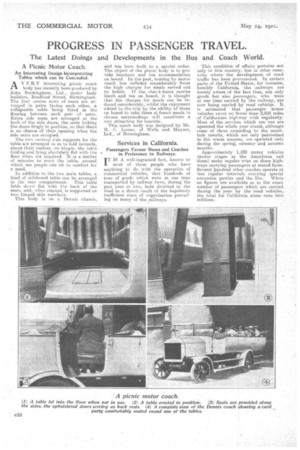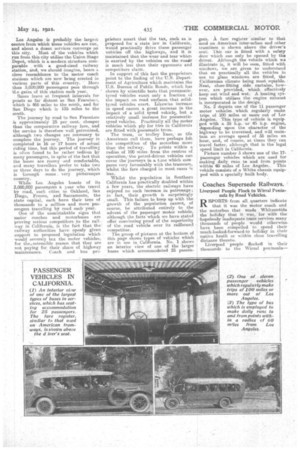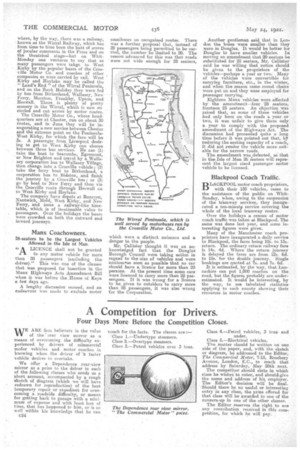PROGRESS IN PASSENGER TRAVEL.
Page 18

Page 19

Page 20

If you've noticed an error in this article please click here to report it so we can fix it.
The Latest Doings and Developments in the Bus and Coach World.
A Picnic Motor Coach.
An Interesting Design Incorporating Tables which can be Concealed.
AVERY interesting picnic coach body has recently been produced by John Buckingham, Ltd., motor body builders, Bradford Street, Birmingham. The four centre rows of Seats are arranged in pairs facing each other, a collapsable table being fitted in the flooring between each pair of seats. Extra side .seats are arranged at the back of the side -doors, the seats locking the doors firnaly in position, so that there is no chance of their Ovning when the aide seats are occupied.
The two vertical sile supports for the table are a,rranged so as to fold inwards, about their centres, on hinges, the table folding and lying absolutely fiat with the floor when not required. It is a matter of minutes to erect the table, around which ten people can sit in comfort for a meal.
In addition to the two main tables, a kind of sideboard table call be arranged in the rear compartment. This table folds down flat with the back of the seats, and, when erected, is supported on two hinged side members.
This body is on a Dennis chassis,
and has been built to a special order. The object of the picnic body is to provide luncheon and tea accommodation on board. In the past, touring by motor coach bias stiffened oansklera,bly ifrom the high charges for meals served out by hotels. If the char-ii-loancs carries lunch and tea on board, it is thought that the charges for meals can be reduced considerably, whilst the enjoyment added to the trip by the ability of those on .board to take these al-fresco meals in chosen surroundings will constitute a now attraction for tourists.
This coach body was designed by Mr. B. C. Lester, of Wells. and Mayner, Ltd., of Birmingham.
Services in California.
Passengers Favour Buses and Coaches in Preference to Railways.
TT IS A well-ingrained fact, known to I most of those people who have anything to do with the operation of commercial vehicles, that hundreds of tons of goods which were at one time transported by railway have, during the past year or two, been diverted to the road as a direct result of the hopelessly inefficient state of organization prevailing on many of the ,railways. This condition of affairs pertains not only in this country, but in other countries where the development of road traffic has been pronounced. In eertaia parts of the United .States, for instance, -notably California,„ the railways are keenly aware of the fact that, not only goods but also passengers, who were at one time carried by the railway, are now being carried by road vehicles. It is estimated that passenger motor vehicles cover no fewer than 2,500 miles of Californian highway with regularity. Most of the services which are run are operated the whole year round, although some of those extending to the mountain resorts, which are only patronized in the warm seasons, are operated only during the spring-, summer and autumn months.
Approximately 1,100 motor vehicles (motor stages as the • Americans call them) Make regular trips on these highways carrying passengers at stated fares. Several hundred other coaches operate at less regular intervals, carrying special excursion parties and the like. While no figures are available as to the exact. number of passengers which. are carried during the year by the road vehicles, the total for California alone runs Into millions.
Los Angeles ia probably the largest centre from ishich these vehieles are run, and about a dozen services converge pn this city. Most of the vehicles which run from this city utilize the Union Stage Depot, which is a modern structure corm parable with a good-sized railway station, and, we should imagine, bears a close resemblance to the motor coach stations which are now being erected in various parts of this country. • More than 3,000,000 passengers pass through 'the gates of this station each year.
_Buses leave at frequentintervals for ponits as far distant as San Francisci, which is 466 miles to the north, and for San Diego which is 135 miles to the south.
The journey by read to San Francisco is approximately 25 per -cent., cheaper than the comparative railway fare, and the service is therefore well patronized, although two changes are necessary to complete the journey. The journey is completed in 16 or 17 hours of actual riding time, but this period of travelling is often found to be rather tedious by many passengers, in spite of the fact that the buses are roomy arid comfortable, and many, travellers prefer to take two or three days to do the journey, which is 'through some very picturesque country.
While. Los Angeles boasts of its 3,000,000 passengers a year who travel by road, such cities as Oakland, San Diego, Fresno, and Sacramento, the state capital, each have their tens of thousands to a million and more, passengers travelling by road each' year.
One of the umnistakable signs that motor coaches and motorbuses are proving serious competitors to the railway in California, is the fact that the railway authorities have openly given support to proposed legislation which would severely tax the motor vehicles, for the, ostensible reason that they are not paying for theirh s—are Of highway
maintenance. Coach and bus pre. prMtors assert that the tax, such as is proposed for a state law in California, would practically drive these passenger vehicles off the highways, and it is roaiatained that thewear and tear which is exerted by the vehicles on the -royals' is much less than their opponents and competitors claim. In support of this fact the proprietors point to the finding of the 'U.S. Department of Agriculture which maintains the U.S. Bureau of Public Roads, which has shown by sCientific tests that pneumatictyred vehicles exert only a fraction of the impact on road surfaces that solidtyred vehicles exert. Likewise increase in speed causes a great increase in the impact of a solid tyred vehicle, but a relatively small increase for pneumatictyred vehicles. Practically all the motor vehicles which ply for hire in California are fitted with pneumatic tyres.
The tram., or trolley lines, as tile Americans call them, have perhaps felt the competition of the motorbus more than the railway. To points within a radius of 100 Miles from the centres of operation,the petrol-driven vehicles can cover the journeys in a time which compares very favourably with the tramcars, whilst the fare charged in most cases is less.
Whilst the population in Southern California has practically doubled within a few years, the electric railways have enjoyed no such increase in patronage; in fact, their _growth is surprisingly small. This failure to keep up with the growth of the population cannot, of course, be attributed entirely to the advent of the passenger motor vehicle, although the facts which we have stated offer convincing proof of the superiority of the road vehicle over its railbound competitor.
The group of pictures at the bottom of this page shows types of vehicles which are in use in California. No. 1 shows an interior view of one of the •larger buses which accommodated 25 passen gers.A fare register similar to that used on American inter-urban and other tramlines is shown above the driver's seat, this ear is fitted with a safety door which can only be opened by the driver. Although the vehicle which we illustrate is, it will be seen, fitted with windows, we are given to understand that on practically all the vehicles in use na glass windows are fitted, the Californian climate being mostequable. Neat, close-fitting side curtains, however, are provided, which effectively keep out wind and wet. A heating system which utilizes the engine exhaust
is incorporated in the design. • No. 2 depicts one of the 11 passenger motor vehicles which regularly make trips of 100 miles or more out of LOP Angeles. This type of vehicle is equipped with a 35 h.p. or 45 h.p. engine, depending upon the claaraoter of the highway to be traversed, and will maintain an average speed of 35 miles an hour, and, of course, at times they can travel faster, although that is the legal speed limit in California. Picture number 3 shows one ef the 17passenger vehicles which are used for making daily rims to and from points within 60 miles of Los Angeles.. This vehicle consists of a White chassis equipped with a specially built body.
Coaches Supersede Railways.
Liverpool People Flock to Wirral Peninsulahy Road Vehicles.
REPORTS from all, quarters indicate that it was the motor coach and the motorbus that made Whitsuntide the holiday that it was, for with the hopelessly inadequate train services many thousands of people would otherwisehave been compelled to spend their much-looked-forward-to holiday in their native heath or within close travelling distance thereto.
Liverpool people fiocketl in their thousands to the Wirral peninsula'—
where, by the way, there was a railemy, • known as the Wirral Railway, which has from time to time been the butt of scores of jocular comments in the Press and on the theatrical stage—but on WhitMonday one ventures to say that as many passengers were taken to West Kirby by the popular buses of the Grosville Motor Co. and coaches of other companies as were carried by rail. West Kirby and Hoylake may be called the " Land's End " of the Wirral Peninsula, and on the Bank Holiday they were fed by bus from Birkenhead, Wallasey, New Ferry, Moreton, Frankhy, Upton, and Heswall. There . is plenty of pretty scenery in the Wirral, which is now en circled and cut across by motor routes. The Crosville Motor Co., whose headquarters are at Chester, run on about 30 routes, and in June they will be inaugurating a new service between Chester and the extreme point on the PeninsulaWest Kirby, for which the fare-will be 3s. A passenger from 'Liverpool desiring to get. to West Kirby can choose between three bus services. He can (1) take the boat to Seacotnbe, Egremont, or New Brighton and travel by a Wallasey corporation bus to Wallasey Tillage, then change into a Crosville vehicle; (2) take the ferry boat to Birkenhead, a corporation bus to Bidston, and finish the journey by a Crosville bus ; or (3) go by boat to New Ferry and then via the Crosville route through Heswall on to West Kirby and Hoylake. The company have depots at. Runcorn, Nantwich, Mold,. West Kirby, and New Ferry, and issue a 'railway-like timetable, which is of inestimable value to passengers. Over the holidays the buses were crowded on both the outward and inward journeys.
Manx Coachowners.
28-seaters to be the Largest. Allowed in the Isle of Mn.
44ALICENCE shall not be granted to any motor vehicle for more than 28 passengers (excluding the driver)." This was one of the clause's that was proposed for insertion in the Manx Highways Acts Amendment Bill when it was before the .House of Keys a few days ago.
A lengthy discussion ensued, and an endeavour was made to exclude motor omnibuses on recognized routes. There was a further proposal that, instead of 28 passengere being permitted to be carried, the number be limited to 20. The reason a,dvanced for this was that roads were not wide enough for 28 seaters, which were a distinct nuisance and a danger to the people.
Mr. Canister thought it was an aref knowledged fact that the Douglas Borough Council were taking action in regaedto the-size of vehicles and were anxioueeso soon as possible that no car should have a licence for more than 20 persons. At the present time some cars were licensed to carry more than 28 passengers. If it was wrong for a licence to be given to outsiders to carry more than 28 passengers, it was also wrong for the Corporation. Another gentleman said that in London the buses were smaller than they were in Douglas. It would be better for Douglas to have smaller vehicles. In moving an amendment that 20 seaters be substituted for 28 seaters' Mr. Catheter said' he was willing that notice should be given to the proprietors of the vehicles—perhaps is year or two. Many of the vehicles were convertible for carrying furniture, etc., in the winter, and when the season came round chairs were put en and they were employed for passenger carrying.
Eighteen Manx vehicles were affected by the amendment—four 28 seaters, fourteen 25 seaters. An objection was raised that, as some of these vehicles had only been on the roads a year or two, it was unfair to give them only, a year to comply with the proposed amendment of the Highways Act. The discussion had proceeded quite a long time before it was pointed out that, by reducing the seating capacity of a coach, it did not render the vehicle more suitable for the narrow roads.
The amendment was defeated, so that in the Isle of Man 28 ‘eaters will represent the largest sized passenger. motor vehicle to be licensed.
Blackpool Coach Traffic.
BLAOKPOOL motor coach proprietors, with their 150 vehicles, came to the assistance of the public on WhitSunday, when, owing to the suspension of the tramway services, they inaugurated a ten-minutp service covering the whole of the local tramway routes.
Over the holidays a census of motor coach traffic was taken at Blackpool. The same was done last year, and some interesting figures were given.
Many of the Manchester coach, proprietors have inaugurated a daily service to Blackpool, the fares being 10s. to 13s. return. The ordinary return railway fare is 14s. 4d. Where the return journey is delayed the fares are from 12s. 6d. to 15s. for the double journey. Single bookings are quoted at 7s.. and 7s. 6d. It is estimated, by the way, that Lancashire can put 1,000 coaches on the road, but the figures probably are. undereseimated. It would be interesting, by the way, to see tabulated statistics applying to each county showing their resources in motor coaches.
































